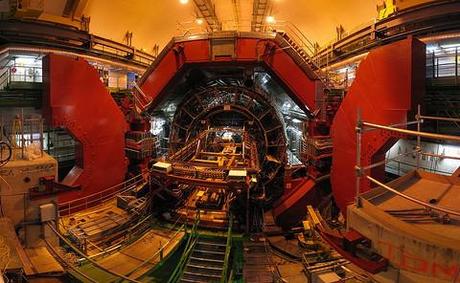
The Large Hadron Collider. Photo credit: Dominick F
Experts may just have pinned down the elusive source of mass nicknamed the “God Particle.” That’s according to multiple reports coming out of an eagerly anticipated seminar at the Cern laboratory in Geneva where Large Hadron Collider (LHC) researchers presented clues in their data which strongly suggest such a subatomic particle, referred to as Higgs boson by those in the know, does very likely exist. The news has sent the science community and commentariat into excited overdrive. Higgs Boson is widely considered the greatest trophy in particle physics and multiple teams of physicians have been working on confirming its existence for decades.
John von Radowitz of the Press Association spelled out the cruciality of Higgs boson: “Dubbed the “God Particle”, the Higgs boson is the last missing piece in the leading theory – known as the Standard Model – that describes how particles and forces interact to make the world we see around us. Scientists have been looking for the Higgs by smashing protons, the ‘hearts’ of atoms, together at enormous energies in the LHC.” He described today’s data presentations as a “tantalising” indication that Higgs is “out there.”
Higgs boson: Keystone of the Universe. “Scientists remained cautious about their findings and insisted they did not represent an official discovery, but admitted the results were “intriguing’”, reported science correspondent Nick Collins at The Daily Telegraph. Collins reminded that if the existence of the “elusive” particle can be confirmed it will “set in stone” a theory proposed by British physicist Peter Higgs in 1946. “It would also provide the final piece of proof required by the Standard Theory, the most widely accepted explanation of how every element in the universe gets its mass.” Professor Higgs suggested that an invisible field lying across the entire cosmos interacts with the tiny particles that make up atoms to give them weight and prevent them from zipping around space at the speed of light. The Higgs boson is the signature evidence of the theory – an unstable particle created moments after the big bang before decaying into smaller particles which form the building blocks of the universe.
Professor Tony Doyle, one of the LHC physicists from the University of Glasgow, told PA: “It’s fair to say that strong hints are what we’re getting right now. My perspective is that this is our Apollo 10 moment. We’ve shown we’ve done everything needed to land on the Moon, or in our case, find the Higgs boson. Confirmation should be very soon in the New Year. I absolutely think we’ll find the Higgs boson next year.”
Huge advance but not quite a discovery. The findings represent “a huge advance in the hunt for the Higgs boson”, though scientists at Cern emphasised that they have not yet made a conclusive discovery, reported The Times (£), which cautioned that there “remains a small but appreciable chance that the spike in the data collected by both experiments could have occurred by chance.” A firm discovery either way should be confirmed by the end of 2012.
“Whether this is ultimately confirmed or we finally rule out a low mass Higgs boson, we are on the verge of a major change in our understanding of the fundamental nature of matter”, exclaimed Claire Shepherd-Themistocleus, head of the CMS group at the Rutherford Appleton Laboratory in Oxfordshire, to The Times (£).

